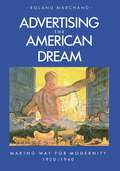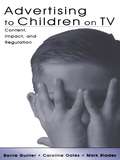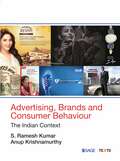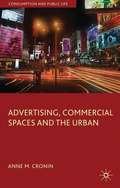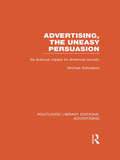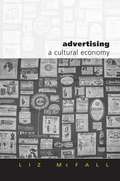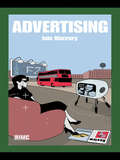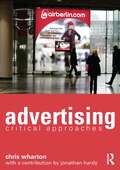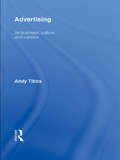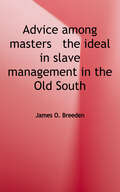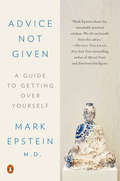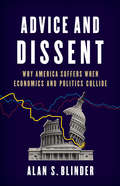- Table View
- List View
Advertising the American Dream: Making Way for Modernity, 1920-1940
by Roland MarchandIt has become impossible to imagine our culture without advertising. But how and why did advertising become a determiner of our self-image? Advertising the American Dream looks carefully at the two decades when advertising discovered striking new ways to play on our anxieties and to promise solace for the masses.As American society became more urban, more complex, and more dominated by massive bureaucracies, the old American Dream seemed threatened. Advertisers may only have dimly perceived the profound transformations America was experiencing. However, the advertising they created is a wonderfully graphic record of the underlying assumptions and changing values in American culture. With extensive reference to the popular media—radio broadcasts, confession magazines, and tabloid newspapers—Professor Marchand describes how advertisers manipulated modern art and photography to promote an enduring "consumption ethic."
Advertising the Self in Renaissance France: Lemaire, Marot, and Rabelais (Early Modern Exchange)
by Scott FrancisAdvertising the Self in Renaissance France explores how authors and readers are represented in printed editions of three major literary figures: Jean Lemaire de Belges, Clément Marot, and François Rabelais. Print culture is marked by an anxiety of reception that became much more pronounced with increasingly anonymous and unpredictable readerships in the sixteenth century. To allay this anxiety, authors, as well as editors and printers, turned to self-fashioning in order to sell not only their books but also particular ways of reading. They advertised correct modes of reading as transformative experiences offered by selfless authors that would help the actual reader attain the image of the ideal reader held up by the text and paratext. Thus, authorial personae were constructed around the self-fashioning offered to readers, creating an interdependent relationship that anticipated modern advertising.Distributed for the University of Delaware Press
Advertising to Children on TV: Content, Impact, and Regulation
by Barrie Gunter Caroline Oates Mark BladesConcern is growing about the effectiveness of television advertising regulation in the light of technological developments in the media. The current rapid growth of TV platforms in terrestrial, sattelite, and cable formats will soon move into digital transmission. These all offer opportunities for greater commercialization through advertising on media that have not previously been exploited. In democratic societies, there is a tension between freedom of speech rights and the harm that might be done to children through commercial messages. This book explores all of these issues and looks to the future in considering how effective codes of practice and regulation will develop.
Advertising to Children: New Directions, New Media
by Barrie Gunter Caroline Oates Mark Blades Fran BlumbergThis important source for students, researchers, advertisers and parents reviews the debates and presents new research about advertising to children. Chapters cover food and alcohol advertising, the effects of product placement and new media advertising, and the role of parents and teachers in helping children to learn more about advertising.
Advertising, Brands and Consumer Behaviour: The Indian Context
by S Ramesh Kumar Anup KrishnamurthyThe book Advertising, Brands and Consumer Behaviour through the exploration of 79 well-known Indian brands, explains how consumer behaviour is applied in conjunction with advertising management and brands. The Indian examples from varied product categories will enable students to identify with the conceptual linkages that occur across branding, advertising and consumer behaviour. The USP of the book is that it adds value and practical insights to the fundamentals dealt with in the various textbooks on the subject. Besides being a reference book for students of post graduate programmes in management, the book will be useful for professionals in the domain of marketing. The exercises presented in the book will enable students to readily connect with the Indian environment. Further, there are references to research readings that will help readers to probe deeper into the linkages across the three subjects. Key Features: Focuses on building conceptual perspectives that trigger critical thinking in a given context Provides real-life examples of brands (creating theory - practice linkages) Covers several well-known Indian brands across product categories Includes online resources explaining the use of the book for instructors of consumer behaviour courses and related subjects.
Advertising, Commercial Spaces and the Urban
by Anne M. CroninProviding a detailed account of contemporary outdoor advertising and its relationship with urban space, this book examines what the outdoor advertising industry tells us about the commercial production of urban space, what industry practices reveal about contemporary capitalism, and how ads and billboard structures interface with spaces of the city
Advertising, Gender and Society: A Psychological Perspective
by Magdalena Zawisza-RileyAdvertising, Gender and Society explores contemporary social-psychological theory and original research that examines the portrayal of gender in advertising. It reports empirical data, discusses the social implications of gendered advertising and comments on the relevant 2019 ASA rules. Zawisza-Riley analyses theories such as stereotype content and elaboration likelihood models, stereotype threat and ambivalent sexism theories, the selectivity hypothesis as well as implicit and embodied cognition to illuminate the relationships between sex, gender and advertising in cultural and social contexts. The author thus examines the portrayal of gender in advertising, its effectiveness and effect on audiences and the ways in which audiences, marketers and policy-makers can mitigate potential harm of gendered advertising. She offers theory extension and novel application of existing theory and research to the subject of gender advertising. Advertising, Gender and Society is ideal for students, academics and professionals in the fields of psychology, gender and media studies as well as marketing, advertising and policy-making.
Advertising, Literature and Print Culture in Ireland, 1891-1922
by John Strachan Claire NallyThis is the first study of the cultural meanings of advertising in the Irish Revival period. John Strachan and Claire Nally shed new light on advanced nationalism in Ireland before and immediately after the Easter Rising of 1916, while also addressing how the wider politics of Ireland, from the Irish Parliamentary Party to anti-Home Rule unionism, resonated through contemporary advertising copy. The book examines the manner in which some of the key authors of the Revival, notably Oscar Wilde and W. B. Yeats, reacted to advertising and to the consumer culture around them. Illustrated with over 60 fascinating contemporary advertising images, this book addresses a diverse and intriguing range of Irish advertising: the pages of An Claidheamh Soluis under Patrick Pearse's editorship, the selling of the Ulster Volunteer Force, the advertising columns of The Lady of the House, the marketing of the sports of the Gaelic Athletic Association, the use of Irish Party politicians in First World War recruitment campaigns, the commemorative paraphernalia surrounding the centenary of the 1798 United Irishmen uprising, and the relationship of Murphy's stout with the British military, Sinn F#65533;in and the Irish Free State.
Advertising, Promotion, and New Media
by Marla R. Stafford Ronald J. FaberToday, new media enter our lives faster than ever before. This volume provides a complete, state-of-the-art overview of the newest media technologies and how they can be used in marketing communications - essential information for any organization that wants to maintain an effective advertising program, as well as for experts and students in the fields of advertising and mass communications. Advertising, Promotion, and New Media offers crucial insights on the use of cutting-edge techniques including 3-D advertising, mobile advertising, advergames, interactivity, and netvertising images, as well as more familiar Internet advertising formats such as banner ads and pop-ups. It also discusses such important topics as how to select online affiliates, and how to assess the effectiveness of new media advertising and compare it with traditional formats. Throughout the book, the chapter authors offer up-to-date information and thought provoking ideas on emerging technology and how it can be used effectively for advertising and promotion in the future.
Advertising, Society, and Consumer Culture
by Roxanne Hovland Joyce M. WolburgDesigned as a core textbook for courses in Advertising and Society, "Advertising, Society, and Consumer Culture" develops an integrated perspective that gives students a framework for understanding past, present, and future issues in advertising communications. Chapter contents cover the entire range of social, political, cultural, regulatory, and economic issues that surround advertising and its role in modern society. The many social issues addressed include advertising and gender stereotyping, advertising to vulnerable audiences, and the distribution of wealth in consumer society. "Advertising, Society, and Consumer Culture" intertwines the development of the consumer culture with its coverage of the historical, political, regulatory, and ethical issues of advertising. It includes clear, comprehensive tables that chronicle historical developments and key legal cases. The text is readable for undergraduates but provides enough depth to serve as a graduate-level text. Including extensive notes and a bibliography, it can be adopted independently, or alongside its companion volume, "Readings in Advertising, Society, and Consumer Culture".
Advertising, The Uneasy Persuasion: Its Dubious Impact on American Society (Routledge Library Editions: Advertising)
by Michael SchudsonWhat does advertising do? Is it the faith of a secular society? If so, why does it inspire so little devotion? Advertising, the Uneasy Persuasion is a clear-eyed account of advertising as both business and social institution. Instead of fuelling the moral indignation surrounding the industry, or feeding fantasies of powerful manipulators, Michael Schudson presents a clear assessment of advertising in its wider sociological and historical framework, persuasively concluding that advertising is not nearly as important, effective, or scientifically founded as either its advocates or its critics imagine. ‘Dispassionate, open-minded and balanced ... he conveys better than any other recent author a sense of advertising as its practitioners understand it.’ Stephen Fox, New York Times Book Review First published in 1984.
Advertising, the Media and Globalisation: A World in Motion
by John SinclairThis book offers a critical, empirically-grounded and contemporary account of how advertisers and agencies are dealing with a volatile mediascape throughout the world, taking a region-by-region approach. It provides a clear, systematic, and synoptic analysis of the dynamic relationship between media, advertisers, and agencies in the age of globalization, and in an era of transition from ‘mass’ to ‘social’ media. Advertising attracts much public criticism for the commercialization of culture and its apparent impact on social and personal life. This book outlines and assesses the issues involved, with regard to how they are manifested in different national, regional and global contexts. Topics covered include: advertising as an object of study global trends in the advertising industry advertising and the media in motion current issues in advertising, media and society advertising, globalization and world regions. While maintaining a contemporary focus, the book explains developments over recent decades as background to the globalisation of what it calls the manufacturing-marketing-media complex.
Advertising: A Cultural Economy (Culture, Representation and Identity series)
by Liz McfallAdvertising is often used to illustrate popular and academic debates about cultural and economic life. This book reviews cultural and sociological approaches to advertising and, using historical evidence, demonstrates that a rethink of the analysis of advertising is long overdue. Liz McFall surveys dominant and problematic tendencies within the current discourse. This book offers a thorough review of the literature and also introduces fresh empirical evidence. Advertising: A Cultural Economy uses a historical study of advertising to regain a sense of how it has been patterned, not by the `epoch', but by the interaction of institutional, organisational and technological forces.
Advertising: Advertising Vol. Iv (Routledge Introductions To Media And Communications Ser.)
by Iain MacRuryAdvertising, once seen as 'the official art of capitalist society' is an increasingly commonplace component of a characteristically promotional culture. Iain MacRury's Advertising offers the means to explore and evaluate this transition with an introduction to advertising for the contemporary reader.Advertising provides a clear and easy guide to a
Advertising: Critical Approaches
by Chris WhartonAdvertising: Critical Approaches explores a broad range of critical theories and perspectives to shed new light on the organisation, workings and effects of the advertising industry today. Chris Wharton presents the social, cultural and economic role of advertising across history, with chapters tracking the process of advertising from production to reception. Split into three sections covering Foundations, Frameworks and Applications, the book’s chapters explore a range of areas central to an insight into the development of modern advertising, including: advertising history cultural, critical and political economy approaches to advertising texts in advertising the reception of advertising advertising in the home and outdoor advertising consumer culture. Case studies explore the diversity in the uses of advertising throughout history, from Ostia and the Square of the Corporations in the ancient Roman world to the UK Border Agency’s ‘Go Home’ campaign and contemporary City branding throughout Europe. Assessing the impact of the works of key critical thinkers including Marx, Morris, Lyotard, Barthes, Saussure, Williams and Hall have had on our understanding of consumption and advertising’s societal impact, Advertising: Critical Approaches illuminates and enhances our understanding and engagement with one of the most vital cultural and economic forces in contemporary society.
Advertising: Its Business, Culture and Careers
by Andy Tibbs‘A no-holds-barred overview of the very competitive but ultimately rewarding industry that is advertising. Insightful, well-informed, frank and honest. An inspirational eye-opener for all Adland wannabes’ – Gyles Lingwood, Course Leader, Creative Advertising, University of Lincoln, UK 'Like the advertising business, Tibbs' book is dynamic, edgy, and challenging. It captures the industry's excitement, energy, intellect, and creativity. The book is an inspiration and should be standard reading for all practitioners, students, and faculty of advertising, marketing, and communications'– Pamela Morris, Loyola University Chicago, USA ‘Tibbs’ insights turn the advertising agency from a mythical wonderland to a realistic career choice. Through reading this book and taking note of his advice, students will be one step closer to walking through its doors’ – Helen Powell, Senior Lecturer, Media and Advertising, University of East London, UK Advertising does not need another graduate! Whether you are an aspiring advertising creative, designer, account manager, PR / publicity consultant or marketing manager, Advertising is an engaging source of inspiration for those dark, idea-less days and a motivator when those job interviews or placements seem in short supply. Its Companion Website at: www.routledge.com/textbooks/advertising supports the book with further examples and ideas to inspire as well as offering up-to-date advice. This book is filled with numerous visual examples of advertising thinking. With words of advice and guidance from some of the industry’s most respected practitioners and insights from graduates who faced the same challenges you will soon encounter in securing that elusive first job. Add to that, an extensive supply of hints and tips to enhance the creative thinking processes, take the work you do beyond what you think you are capable of and, crucially, gain an edge at job interviews. Maybe advertising doesn’t need another graduate, but then you won’t be just another graduate will you?
Advice Among Masters: The Ideal in Slave Management in the Old South (Contributions In Afro-american And African Studies #No. 51)
by James O. BreedenThis collection of documents on slavery is like no other: it portrays plantation slavery from the point of view of the masters. They are in this case those slaveholders who wrote on the ideal in slave manage¬ment for the southern agricultural press during the four decades pre¬ceding the Civil War. Slave management studies were a prominent and frequent feature of the South's farm journals. An extensive sampling of these studies is included here to make readily accessible an important source for the study of slavery.
Advice And Support: The Early Years 1941-1960 [Illustrated Edition]
by Ronald H. SpectorIncludes over 75 maps, photos and plans.The present volume describes the activities of the U.S. Army in Vietnam during World War II, military advice and assistance to the French government during the immediate post-war years, and the advisory program that developed after the Geneva Agreements of 1954. Its scope ranges from high-level policy decisions to low-echelon advisory operations in the field, presented against a background of relevant military and political developments. The author enjoyed access to the official records of the period and examined personal papers, interviews, other documentary sources, and miscellaneous published materials. Useful not only as a study of military assistance but as a view of the Army as an agent of national policy, this volume is a fitting introduction to the overall study of the conflict in Vietnam.
Advice And Support: The Final Years 1965-1973 [Illustrated Edition]
by Jeffrey J. ClarkeIncludes over 75 maps, photos and plans.In Advice and Support: The Final Years the author describes the U.S. Army advisory effort to the South Vietnamese armed forces during the period when the U.S. commitment in Southeast Asia was at its peak. The account encompasses a broad spectrum of activities at several levels, from the physically demanding work of the battalion advisers on the ground to the more sophisticated undertakings of our senior military officers at the highest echelons of the American military assistance command in Saigon. Among critical subjects treated are our command relationships with the South Vietnamese army, our politico-military efforts to help reform both the South Vietnamese military and government, and our implementation of the Vietnamization policy inaugurated in 1969. The result tells us much about the U.S. Army's role as an agent of national policy in a critical but often neglected arena, and constitutes a major contribution to our understanding of not only the events that occurred in Vietnam but also the decisions and actions that produced them.
Advice Not Given: A Guide to Getting Over Yourself
by Dr EpsteinOur ego, and its accompanying sense of self-doubt, is one affliction we all share. And while our ego claims to have our best interests at heart, in its never-ending pursuit of attention and power, it sabotages the very goals it sets to achieve. In Advice Not Given, renowned psychiatrist and author Dr Mark Epstein reveals how Buddhism and Western psychotherapy both identify the ego as the limiting factor in our wellbeing and both come to the same conclusion: when we give the ego free rein, we suffer; but when it learns to let go, we are free.Our ego is at once our biggest obstacle and our greatest hope. We can be at its mercy or we can learn to mould it. Completely unique and practical, Epstein's advice can be used by all, and will provide wise counsel in a confusing world.
Advice Not Given: A Guide to Getting Over Yourself
by Mark EpsteinOur ego, and its accompanying sense of nagging self-doubt as we work to be bigger, better, smarter, and more in control, is one affliction we all share. And while our ego claims to have our best interests at heart, in its never-ending pursuit of attention and power, it sabotages the very goals it sets to achieve. In Advice Not Given, renowned psychiatrist and author Dr. Mark Epstein reveals how Buddhism and Western psychotherapy, two traditions that developed in entirely different times and places and, until recently, had nothing to do with each other, both identify the ego as the limiting factor in our well-being, and both come to the same conclusion: When we give the ego free reign, we suffer; but when it learns to let go, we are free. With great insight, and in a deeply personal style, Epstein offers readers a how-to guide that refuses a quick fix, grounded in two traditions devoted to maximizing the human potential for living a better life. Using the Eightfold Path, eight areas of self-reflection that Buddhists believe necessary for enlightenment, as his scaffolding, Epstein looks back productively on his own experience and that of his patients. While the ideas of the Eightfold Path are as old as Buddhism itself, when informed by the sensibility of Western psychotherapy, they become something more: a road map for spiritual and psychological growth, a way of dealing with the intractable problem of the ego. Breaking down the wall between East and West, Epstein brings a Buddhist sensibility to therapy and a therapist's practicality to Buddhism. Speaking clearly and directly, he offers a rethinking of mindfulness that encourages people to be more watchful of their ego, an idea with a strong foothold in Buddhism but now for the first time applied in the context of psychotherapy. Our ego is at once our biggest obstacle and our greatest hope. We can be at its mercy or we can learn to mold it. Completely unique and practical, Epstein's advice can be used by all--each in his or her own way--and will provide wise counsel in a confusing world. After all, as he says, "Our egos can use all the help they can get. "
Advice and Consent: The Politics of Judicial Appointments
by Lee Epstein Jeffrey A. SegalFrom Louis Brandeis to Robert Bork to Clarence Thomas, the nomination of federal judges has generated intense political conflict. With the coming retirement of one or more Supreme Court Justices--and threats to filibuster lower court judges--the selection process is likely to be, once again, the center of red-hot partisan debate. In Advice and Consent, two leading legal scholars, Lee Epstein and Jeffrey A. Segal, offer a brief, illuminating Baedeker to this highly important procedure, discussing everything from constitutional background, to crucial differences in the nomination of judges and justices, to the role of the Judiciary Committee in vetting nominees. Epstein and Segal shed light on the role played by the media, by the American Bar Association, and by special interest groups (whose efforts helped defeat Judge Bork). Though it is often assumed that political clashes over nominees are a new phenomenon, the authors argue that the appointment of justices and judges has always been a highly contentious process--one largely driven by ideological and partisan concerns. The reader discovers how presidents and the senate have tried to remake the bench, ranging from FDR's controversial "court packing" scheme to the Senate's creation in 1978 of 35 new appellate and 117 district court judgeships, allowing the Democrats to shape the judiciary for years. The authors conclude with possible "reforms," from the so-called nuclear option, whereby a majority of the Senate could vote to prohibit filibusters, to the even more dramatic suggestion that Congress eliminate a judge's life tenure either by term limits or compulsory retirement. With key appointments looming on the horizon, Advice and Consent provides everything concerned citizens need to know to understand the partisan rows that surround the judicial nominating process.
Advice and Dissent: Why America Suffers When Economics and Politics Collide
by Alan S. BlinderA bestselling economist tells us what both politicians and economists must learn to fix America's failing economic policiesAmerican economic policy ranks as something between bad and disgraceful. As leading economist Alan S. Blinder argues, a crucial cultural divide separates economic and political civilizations. Economists and politicians often talk--and act--at cross purposes: politicians typically seek economists' "advice" only to support preconceived notions, not to learn what economists actually know or believe. Politicians naturally worry about keeping constituents happy and winning elections. Some are devoted to an ideology. Economists sometimes overlook the real human costs of what may seem to be the obviously best policy--to a calculating machine. In Advice and Dissent, Blinder shows how both sides can shrink the yawning gap between good politics and good economics and encourage the hardheaded but softhearted policies our country so desperately needs.
Advice for Callow Jurists and Gullible Mendicants on Befriending Emirs
by Adam Sabra Abd al-Wahhab al-SharaniThis mirror for princes sheds light on the relationship between spiritual and political authority in early modern Egypt This guide to political behavior and expediency offers advice to Sufi shaykhs, or spiritual guides, on how to interact and negotiate with powerful secular officials, judges, and treasurers, or emirs. Translated into English for the first time, it is a unique account of the relationship between spiritual and political authority in late medieval / early modern Islamic society.
